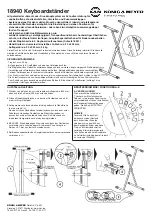
B. SETUP VARIATIONS
CHECK, MAINTENANCE, CLEANING
In the event of workstation maintenance pay attention to possible risks
(the stand is bumped into, pinching/ wedging). To care for the product
use a damp cloth and a non-abrasive cleaning agent.
FAULT FINDING (F) & REMEDY (R)
F: Stand is not stable:
F:
B: Adjust balance end caps, check surface.
F: Height/width of the stand does not fit:
F:
B: Select a different hole in the disk.
F: Keyboard is not firmly placed on the stand (unstable):
F:
B: Check the bottom of the keyboard for uneven surfaces.
F:
B: Adjust the width of the stand.
F: The keyboard is not placed on the rubber rests:
F:
B: Adjust the back rubber rings to the proper position.
C. DIMENSIONS
Transportation setting (cardboard packaging)
D. ADJUST BASES
The distances between the rubber rests can be adjusted
to the dimensions of the instrument. Just push the rubber
rests to the front until the correct distance has been
selected.
TECHNICAL DATA
Material
Tubes, struts: Steel, powder coated black
Screws, nuts, U-disks: Steel, galvanized
Locking pin: Steel, nickel plated
End caps, rubber rests/top:TPE, shore 59A
Handle, disk, caps: PA, PE
Load
max. 40 kg
Dimensions
Example: Height 620 x width 780 mm
Support tubes: ø 30 x 350 mm; Base tubes: ø 30 x 500 mm
Packaging
Box: 1020 x 520 x 102 mm
Weight
4.3 kg
Accessories
Carrying Case 18959-000-00, Stacker 18941-000-55
Keyboard “large”
Keyboard “small”
NOT OK:
Overlaps too much
NOT OK:
does not overlap
enough
NOT OK:
Not centered
OK:
Overlap
adequate
OK:
Overlap
adequate
OK:
Centered
NOT OK:
Overlaps too much
NOT OK:
Overlaps too much
OK:
Centered
OK:
- centered
- adequate
-
overlap
NOT OK:
- does not
-
overlap enough
-
overlaps too much
- not centered
E. TIPS on how to secure the keyboard






















